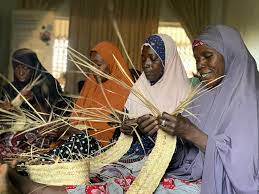
Natural rubber, chemically 1,4 cis-polyisoprene, is a polymer with some unique properties besides superior elasticity. Natural rubber is extracted from the latex produced by a tree, Hevea brasiliensis, indigenous to the tropical rainforests of Central and South America. Although there are thousands of lactiferous (latex vessel bearing) species in the plant kingdom, only about two thousand, five hundred (2,500) species contain rubber in their latex.
Natural rubber is a vital agricultural commodity in Nigeria. The Federal Department of Agriculture first planted its rubber plot in 1906, and in between 1909 and 1917 about two thousand, one hundred and sixty (2,160) hectare of rubber trees were planted in Nigeria. From 1960s to the early 1970s rubber used to be the fourth most valuable Nigerian agricultural export commodity after cocoa, groundnuts and palm kernels.
It has suffered a significant decline from its pre-eminent position in the seventies due to the emergence of the petroleum industry as a major contributor of the national economy. Nigeria is among the largest producers of natural rubber in Africa, with a production capacity of over one hundred and forty-five thousand (145,000) metric tonnes in 2020. Rubber is grown in Edo, Delta, Ondo, Ogun, Abia, Anambra, Akwa Ibom, Cross Rive, Rivers, Ebonyi and Bayelsa states.
Rubber farming is an excellent agricultural venture that holds great potential for profitability and sustainability in Nigeria. With its favorable climatic conditions and vast agricultural resources, Nigeria is well-suited for rubber cultivation.
This article aims to provide a step-by-step guide for aspiring rubber farmers, covering everything from land preparation and seed selection to cultivation practices, pest management, and marketing strategies. Whether you are a new farmer looking for a lucrative business opportunity or an existing farmer seeking to diversify your agricultural activities, this guide will serve as a valuable resource to kick-start your rubber farming venture in Nigeria.
Conducting a Feasibility Study
Before embarking on any farming endeavor, it is crucial to conduct a feasibility study to assess the viability and potential profitability of rubber farming in your chosen location. Factors to consider include soil suitability, climatic conditions, market demand, availability of resources, and proximity to transportation facilities. Seek expert advice from agricultural extension officers, visit successful rubber farms, and analyze market trends to make informed decisions.
Land Preparation
Choose a well-drained, fertile land with a pH level between 4.5 and 6.0 for optimum rubber growth. Clear the land of bushes, stumps, and rocks and plow the soil to a depth of about 30 centimeters. Incorporate organic matter such as compost or farmyard manure to improve soil fertility. Plan the layout of the farm, ensuring proper spacing between rubber trees for efficient growth and maintenance.
Seed Selection and Planting
Select high-quality rubber tree seeds from reputable nurseries or research institutes to ensure healthy and productive plants. Common rubber varieties in Nigeria include RRIM 600, GT1, and Tjir 1.
Hevea Brasiliensis (Natural Rubber): Hevea Brasiliensis, commonly known as natural rubber, is the primary variety cultivated in Nigeria. It thrives in the humid tropical regions of the country, making states like Edo, Delta, Ondo, Rivers, and Cross River ideal for its cultivation.
The natural rubber tree is a medium-sized evergreen with a straight trunk, and it reaches maturity in about six to seven (6-7) years.
Clones and Hybrid Varieties: In addition to natural rubber, Nigeria has seen a rise in the cultivation of clones and hybrid varieties. These varieties offer improved disease resistance, higher yield potential, and faster maturation.
a) RRIM 600: RRIM 600 is a popular clone variety cultivated in Nigeria. It is known for its high yield potential, early maturity (around five years), and resistance to diseases such as South American leaf blight (SALB). This variety is suitable for various regions across Nigeria.
b) Tjir 1: Tjir 1 is a hybrid rubber variety that exhibits resistance to diseases and pests. It matures early, around five to six years, and possesses high latex yield potential. This hybrid variety is increasingly gaining popularity among farmers.
c) RRIC 100 and RRIC 121: RRIC 100 and RRIC 121 are high-yielding rubber varieties developed by the Rubber Research Institute of Nigeria. These varieties possess excellent latex production potential, making them suitable for commercial rubber farming.
Prepare a nursery by filling polybags with a mixture of soil, sand, and compost. Sow the seeds at a depth of 2-3 centimeters and maintain adequate moisture and shade in the nursery. Transplant the seedlings when they reach a height of 30-40 centimeters.
Cultivation Practices
Rubber trees require regular care and maintenance to ensure optimal growth and latex production. Prune the trees to remove diseased or overcrowded branches and facilitate air circulation. Provide adequate irrigation during dry spells and apply appropriate fertilizers based on soil nutrient deficiencies. Mulching can help conserve moisture and suppress weed growth. Regular weeding is essential to prevent competition for nutrients and space.
Pest and Disease Management
Common pests in rubber farming include mites, leafhoppers, and nematodes.
Common Pests in Rubber Farming
Rubber Stem Borer (Hypothenemus spp.): The rubber stem borer is a major pest that attacks the stems of rubber trees, causing severe damage. Signs of infestation include holes on the stems, sawdust-like frass, and wilting of leaves. Preventive measures include regular pruning and removal of affected stems, proper sanitation practices, and the use of appropriate insecticides.
Red Spider Mite (Tetranychus spp.): Red spider mites are tiny pests that feed on rubber leaves, leading to discoloration, leaf drop, and reduced photosynthesis. These pests thrive in hot and dry conditions. Effective control measures include maintaining proper humidity levels, regular monitoring, and using acaricides.
Mealybugs (Phenacoccus spp.): Mealybugs are sap-sucking insects that attack rubber trees, causing leaf deformation, stunted growth, and honeydew secretion. Natural enemies like ladybugs and lacewings can help control mealybug populations. Additionally, regular inspection and the use of appropriate insecticides or horticultural oils can be employed.
Rubber Aphids (Pentalonia spp.): Rubber aphids infest leaves and young shoots, resulting in distorted growth and sooty mold development. Cultural practices such as weed control and maintaining plant vigor can prevent infestations. Insecticides and biological control agents can be used when necessary.
Common Diseases in Rubber Farming
South American Leaf Blight (Microcyclus ulei): South American leaf blight is a devastating fungal disease that affects rubber trees, leading to defoliation and reduced latex production. Planting resistant varieties, maintaining proper tree spacing, and strict sanitation practices are crucial for disease management. Fungicides can be applied preventively or curatively.
Powdery Mildew (Oidium heveae): Powdery mildew appears as a white powdery growth on rubber leaves, hindering photosynthesis and reducing latex yield. Promoting good airflow, reducing shade levels, and applying appropriate fungicides can help control the disease.
Pink Disease (Corticium salmonicolor): Pink disease is caused by a fungus that attacks the bark and cambium layer of rubber trees. Affected trees exhibit pinkish, slimy patches, and eventual bark decay. Pruning and removing infected branches, improving drainage, and applying copper-based fungicides are important management strategies.
Phytophthora Diseases (Phytophthora spp.): Phytophthora species cause root and collar rots, leading to tree wilting and death. Proper drainage, avoiding waterlogging, and planting in well-drained soils are crucial preventive measures. Fungicides can be used as a last resort.
Harvesting and Processing
Rubber trees start producing latex after about five to six (5-6) years. The Nigerian Rubber Research Institute estimates that seed yield from rubber plantations varies from one hundred to one hundred and fifty (100 to 150) kilograms per hectare, depending on soil fertility and crop density.
Implement a tapping schedule and technique to maximize latex yield without harming the tree. The most common method is the spiral or herringbone tapping system. Collect the latex in cups attached to the trees and transfer it to a collection vessel. Process the latex into rubber sheets through coagulation, sheet rolling, and drying processes.
Marketing and Sales
Develop a marketing plan to promote your rubber produce effectively. Establish connections with rubber processors, local traders, and manufacturers who require raw materials for various rubber-based industries. Participate in agricultural fairs, trade exhibitions, and online platforms to showcase your products. Build long-term relationships with buyers and explore export opportunities to increase profitability.
In conclusion, Rubber farming in Nigeria offers immense potential for profitable agricultural investment. By following the steps outlined in this comprehensive guide, aspiring rubber farmers can establish a successful and sustainable rubber plantation.
Remember to continuously update your knowledge and adopt modern farming practices to stay ahead in the industry. With proper planning, diligent care, and effective marketing strategies, rubber farming can become a lucrative business venture contributing to Nigeria's agricultural growth and economic development.






















